Texas’s coastline along the Gulf of Mexico offers a captivating blend of diverse ecosystems and often tranquil waters. The warm waters along the Texas Gulf Coast create a unique environment that supports a wide variety of marine life. And while many creatures from the ocean create imagination and intrigue, they are not all friendly. Much of the marine life you may encounter along the Texas coast is actually quite dangerous. Below, we will explore the ten most dangerous animals swimming off the coast of Texas.

What Is the Texas Gulf Coast?
The Gulf of Mexico is an expansive body of water primarily encompassed by countries on the North American continent. It is, however, connected to the Atlantic Ocean and the Caribbean Sea. The roughly 367 miles of Texas shoreline that abuts the Gulf of Mexico is called the Texas Gulf Coast. It is riddled with estuaries, barrier islands, and other waterways connecting inland rivers with the ocean.
There are five state parks and one national shoreline along the entire expanse. Additionally, the area has rich habitats that provide shelter, feeding grounds, and breeding sites for countless fish species, invertebrates, and marine mammals. There is also a stunning array of animals along the shoreline, leading to the development of ten wildlife sanctuaries along the Texas coast.
Bull Shark (Carcharhinus leucas)
Most people think about Great White Sharks when they picture a fear-inducing marine predator. However, the bull shark (which belongs to the Carcharhinidae family) is a powerful predator that inhabits coastal waters worldwide, including those off the Texas coast. It is definitely one of the most dangerous animals swimming in Texas waters! Bull sharks can tolerate saltwater and freshwater environments, so they often venture into estuaries and bays.
They have a muscular build, dark gray or brownish coloration, and a broad, blunt snout. Bull sharks are territorial and may exhibit aggressive behavior if provoked. Attacks from bull sharks are the most common shark attacks reported along the Texas gulf coast. One easy way to avoid chancing an encounter is to not venture into the water during their peak feeding times — around dusk and dawn.
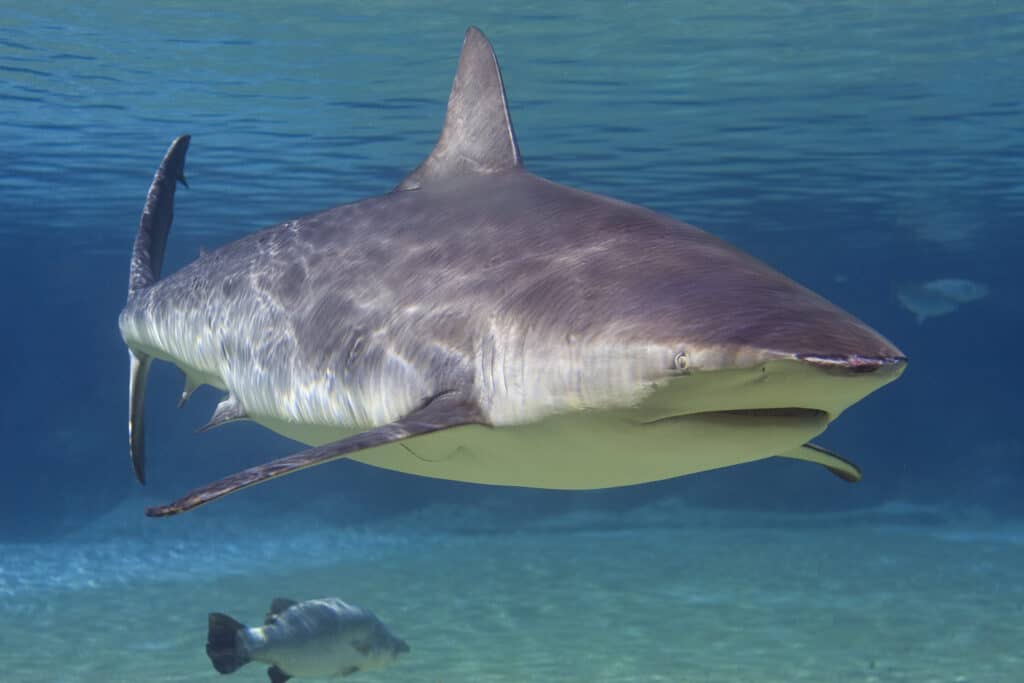
Bull Sharks (
Carcharhinus leucas) have a muscular build, dark gray or brownish coloration, and a broad, blunt snout.
©Ian Scott/Shutterstock.com
Jelly Fish (Scyphozoa)
Most people are likely familiar with the notorious jellyfish, whose sting tends to cause a painful, burning sensation. The lovely underwater creatures are mesmerizing to watch as they float through the water effortlessly. But they are incredibly dangerous. In fact, more people die from jellyfish stings annually than from shark attacks.
Keep an eye out and listen to warnings of any jellyfish-infested areas. And do your best to steer clear of this animal.
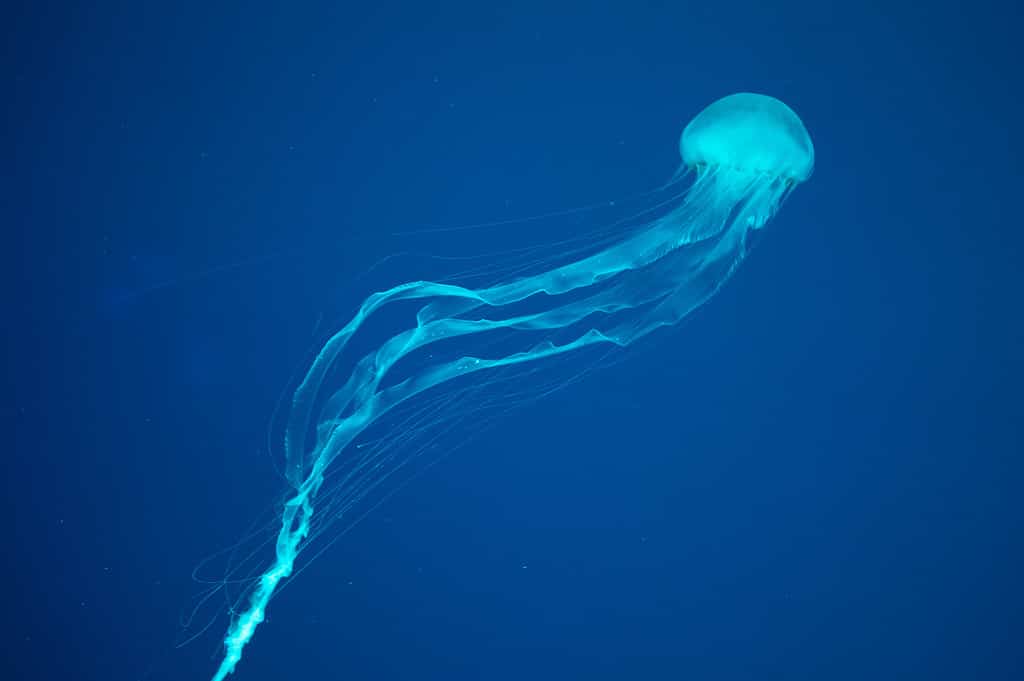
Jellyfish are fun to watch but don’t get too close. The long tentacles deliver a powerful sting.
©IMC11/Shutterstock.com
Portuguese Man o’ War (Physalia physalis)
The Portuguese Man o’ War from the Physaliidae family is often mistaken for a jellyfish. But it is a unique marine creature. It is not a single organism but a colony of specialized organisms called zooids working together. It has a gas-filled float resembling a balloon sitting on the water’s surface. And its long, trailing tentacles extend below. The tentacles can reach up to 165 feet long and deliver venomous stings.
Those stings can cause intense pain, welts, and even allergic reactions. Unfortunately, they are not uncommon along the Texas coastline. That is because the deadly sea creature does not have a way to propel itself through the water. It relies on currents and waves to carry it, so it frequently ends up along the shallow coastline or the beach.
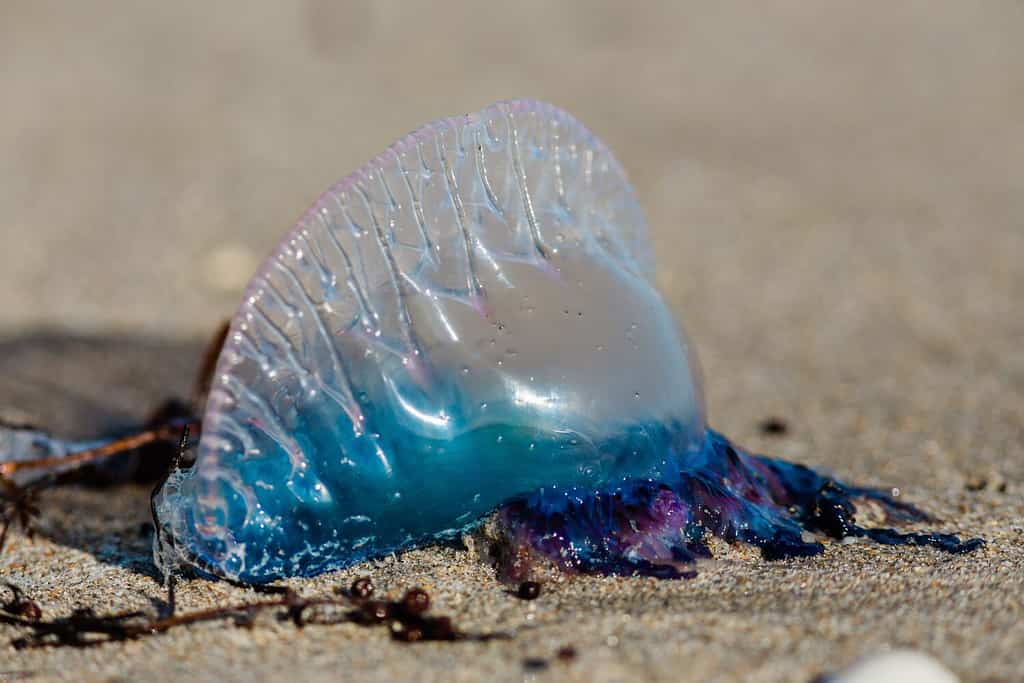
The Portuguese Man o’ War from the
Physaliidaefamily is not a single organism but a colony of zooids working together.
©kpkellyfl/Shutterstock.com
Stingrays (Dasyatidae family)
The beautiful gliding stingrays are a common sight in the shallow coastal waters of Texas, especially in sandy or muddy environments. But don’t let their appearance fool you. These flat-bodied creatures have a venomous barb at the base of their tail, which they deploy for self-defense.
The good news is that stingrays are generally docile and prefer to avoid human interaction. However, accidentally stepping on or provoking a stingray can result in a painful sting. The venom from their barb can cause intense pain, swelling, and even secondary infections. Experts advise shuffling your feet while wading in shallow water to alert stingrays to your presence.
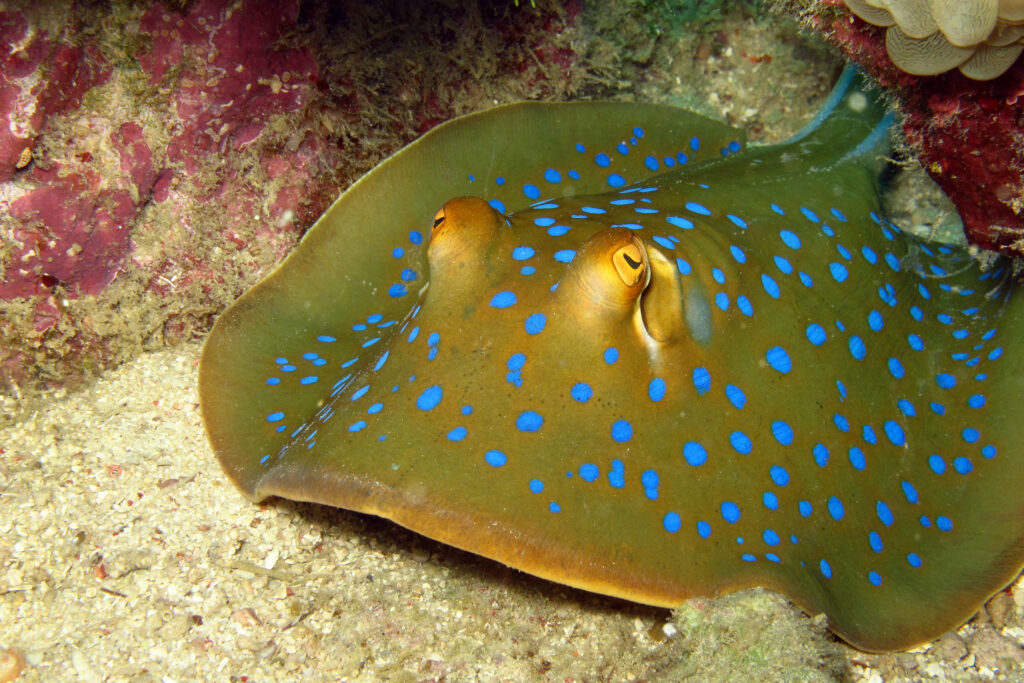
Stingrays (
Dasyatidae family) prefer hanging out on the bottom of the ocean or coral reefs and are often difficult to spot.
©Paranee Hansakul/Shutterstock.com
Sea Urchin (Millepora spp.)
These adorable marine animals are more than meets the eye. They can also pack a powerful (and painful) punch. Sea urchins are covered in spines as a self-defense mechanism. But if you inadvertently step on one while walking along the sea floor, it will sting. Additionally, if one of the spines breaks off in your skin, you will likely need surgery to get it removed.
The good news is that one sting is not the end of the world, despite the discomfort you may feel. However, when people get stung multiple times, they may experience fatigue, severe pain, difficulty breathing, or death.
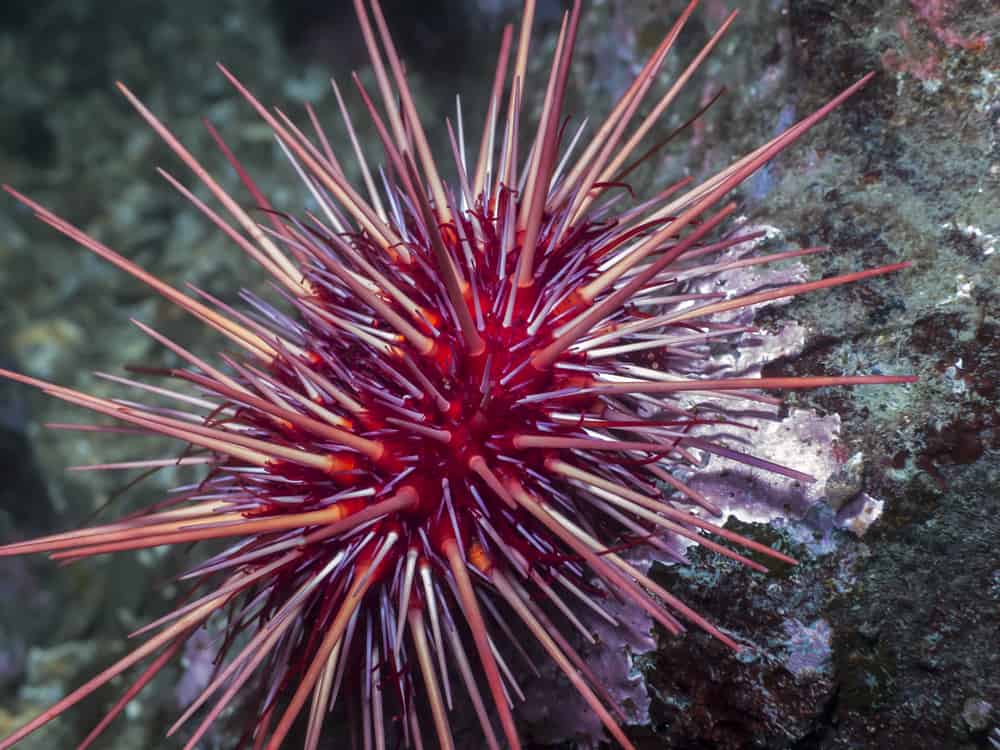
Sea urchins (
Millepora spp.) look pretty but pack a powerfully painful punch if you step on one.
© NatureDiver/Shutterstock.com
Alligator Gar (Atractosteus spatula)
The alligator gar is an ancient fish species that belongs to the Lepisosteidae family. And while it primarily inhabits freshwater locations, that is not the only place you will find these highly dangerous animals. They are equally happy in saltwater habitats and have gotten spotted in the brackish estuaries along the coast as well as in the surf itself.
These large predators can reach lengths of up to ten feet. Their long snout and sharp teeth make them formidable hunters. Respect their presence and use caution when you spot one to avoid an unpleasant encounter.
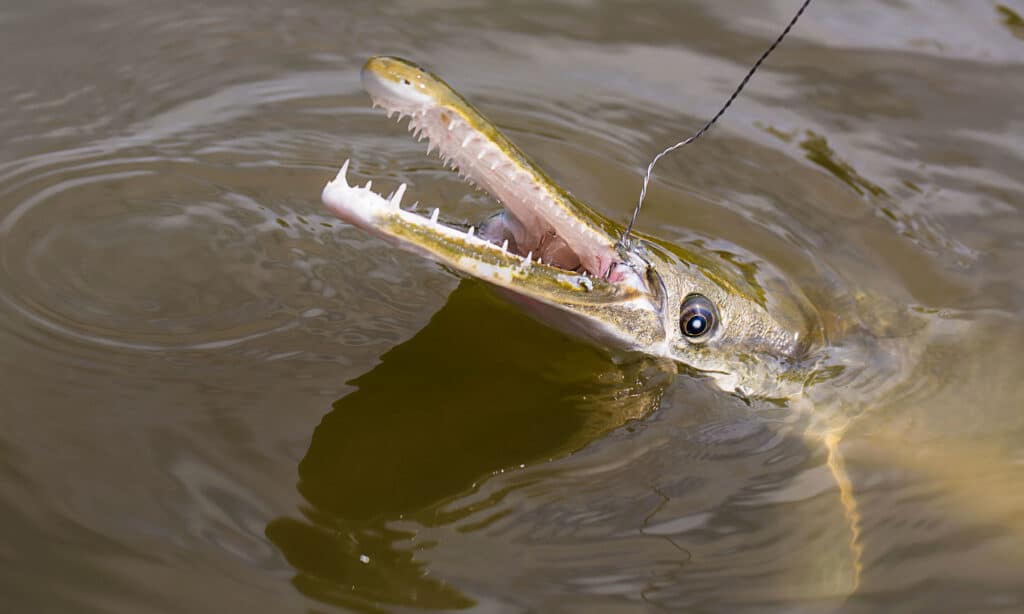
The
alligator
gar is an ancient fish species that belongs to the
Lepisosteidaefamily.
©Jennifer White Maxwell/Shutterstock.com
Barracuda (Sphyraena spp.)
Most people are probably familiar with the barracuda, by reputation at least. It belongs to the Sphyraenidae family and definitely lives up to the hype. They are sleek and formidable predators that frequent reefs, piers, and inshore waters along the Texas coast. Their streamlined bodies, sharp teeth, and ability to swim at a shocking speed mean they are capable of inflicting serious injuries.
The biggest concern with barracudas is that they are unpredictable. If one is near you, there is no telling whether it will pass you by or head in for an attack.
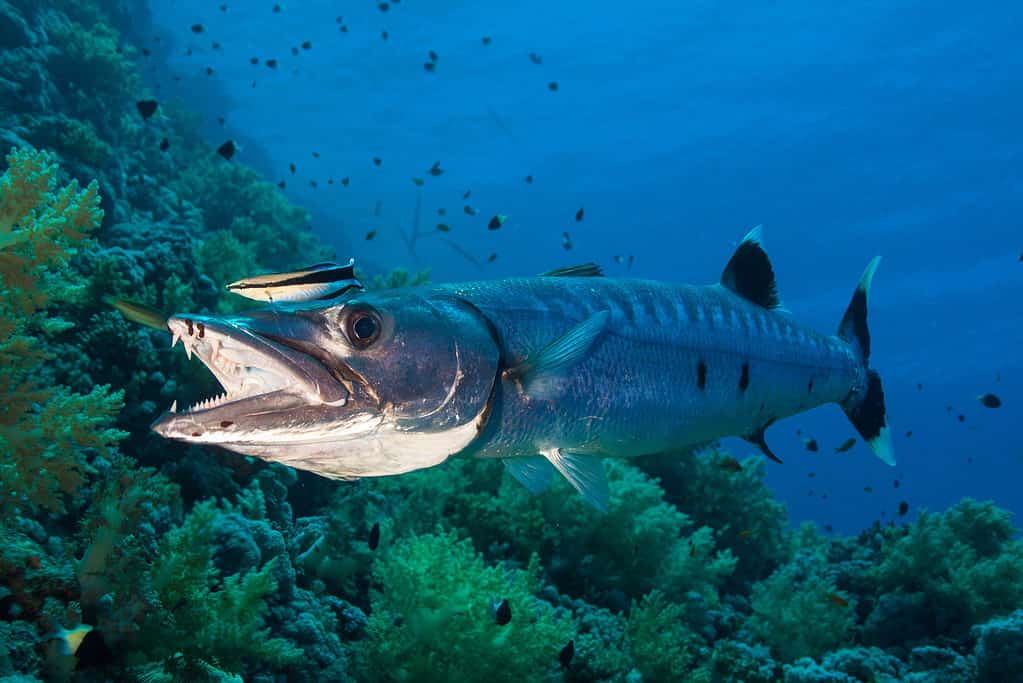
Barracuda are sleek and formidable predators that frequent reefs, piers, and inshore waters along the Texas coast.
©Itstvan Kovacs/Shutterstock.com
Stonefish (Synanceia spp.)
The stonefish, which belongs to the Synanceiidae family, holds the title of the most venomous fish in the world. And it can be found along the Texas coastline. With its remarkable camouflage, the stonefish blends in with rocks and sandy bottoms. This ingenious disguise makes it difficult to spot. Its venomous spines cause excruciating pain, swelling, and tissue necrosis. Wear protective footwear when wading or snorkeling in the warm, shallow water near coral reefs. And be cautious of where you step to help prevent encounters with these dangerous animals.
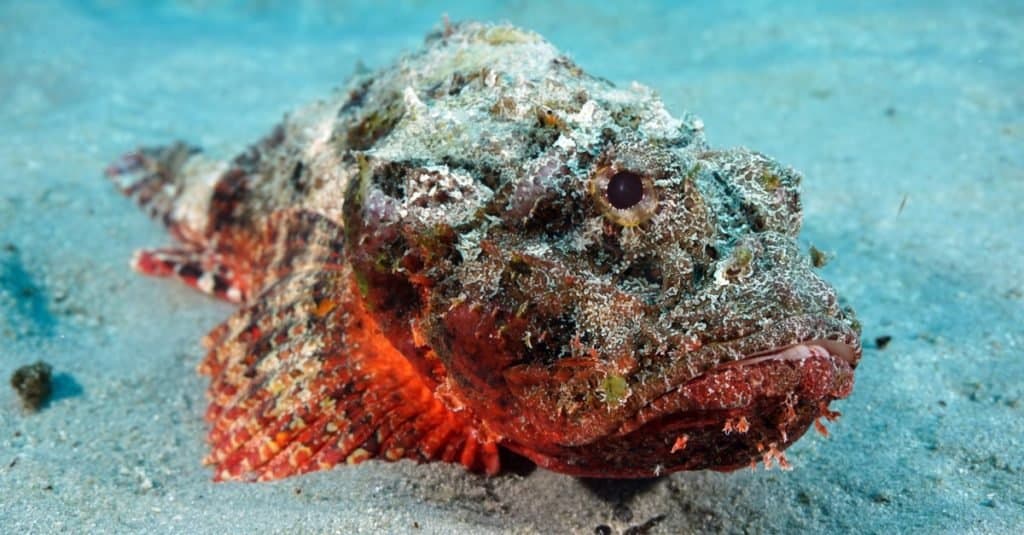
Stonefish are hard to spot and extremely dangerous.
©Matt9122/Shutterstock.com
Sea Snakes (Hydrophiinae spp.)
These slithering aquatic snakes belong to the Elapidae family. Though they are relatively rare in Texas waters, sea snakes do sometimes make their way into the Gulf of Mexico. These venomous reptiles possess potent neurotoxins. Do your best to avoid them at all costs. Thankfully, their painful and dangerous bites are rare. But you should still maintain a safe distance if you encounter one.

Venomous sea snakes don’t always show up along the Texas coastline, but they do come along often enough to stay on guard.
©IHX/Shutterstock.com
Lionfish (Pterois spp.)
Lionfish belong to the Scorpaenidae family. They are originally from the Indo-Pacific region but have made their way into the waters of the Gulf of Mexico, including the Texas coast. This invasive species is carnivorous and boasts venomous spines capable of delivering a painful sting. They have a striking appearance, thanks to their vibrant colors and flowing fins.
These venomous creatures love hanging out in reefs and rocky outcrops. So if you happen to be swimming or snorkeling in an area like this, use extra caution. The good news is that they are so distinctive, it is often easier to spot them than other dangerous marine animals.
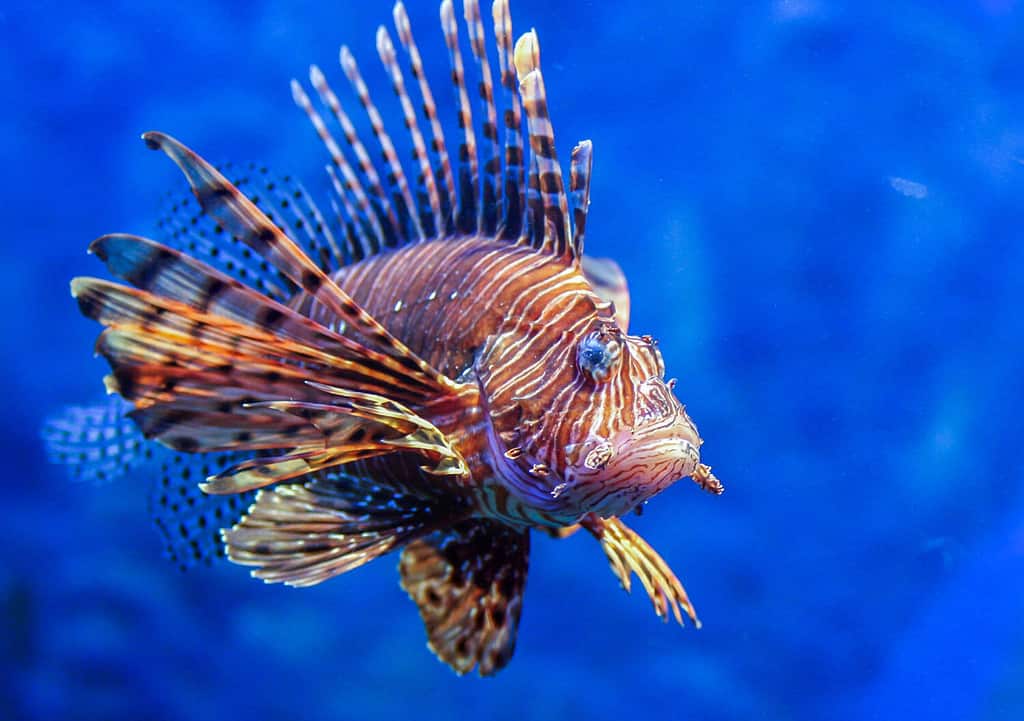
Lionfish
are originally from the Indo-Pacific region but have made their way into the waters of the Gulf of Mexico.
©dimakig/Shutterstock.com
Summary of 10 Dangerous Animals Along the Texas Coast
| Rank | Animal |
|---|---|
| 1 | Bullshark |
| 2 | Jelly Fish |
| 3 | Portuguese Man o’ War |
| 4 | Stingrays |
| 5 | Sea Urchin |
| 6 | Alligator Gar |
| 7 | Barracuda |
| 8 | Stonefish |
| 9 | Sea Snakes |
| 10 | Lionfish |
The photo featured at the top of this post is © Willyam Bradberry/Shutterstock.com
Thank you for reading! Have some feedback for us? Contact the AZ Animals editorial team.







